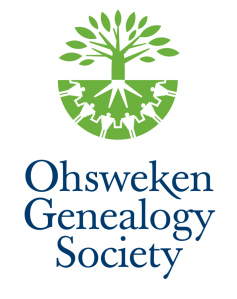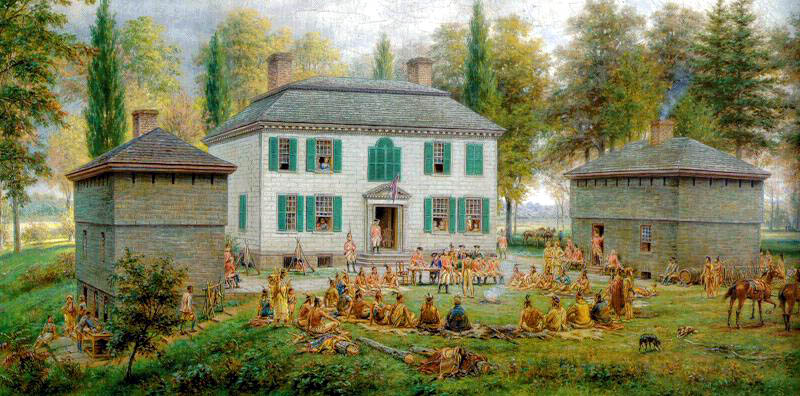
Johnson Hall, Home and Headquarters of Sir William Johnson and the Iroquois Nations. Painted by Artist: Edward Lamson Henry in 1772
Haudenosaunee-British Alliance
by David Kanowakeron Hill Morrison UE
Prior to and during the Revolutionary War, few families were so influential to the Haudenosaunee-British alliance than the Brants and the Johnsons.
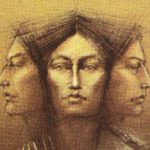
“The Three Faces of Molly Brant” (Iroquois, European, Loyalist)
Molly Koñwatsiãtsiaiéñni Brant (b.abt.1736, d.1796) and her brother, Joseph Thayendanegea Brant (b.1742, d.1807), would serve as liaisons, delegates and advisories that serve the British cause without compare.
Sir William Johnson (b.1715, d.1774), Superintendent of Indian Affairs for the Six Nations, used a sense of duty with a solid measure of respect to develop a relationship that – if not overtly balanced – was at least one that bore some semblance of equality that was lacking in the land-greedy Colonists. His marriage to Molly Brant would have far reaching implications, most notably to the education and advantages he afforded to her brother Joseph.
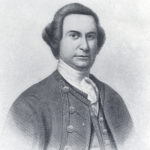
Sir William Johnson
Upon the death of Sir William, his eldest son John Johnson (b.1741, d.1830) would inherit his father’s title and land holdings. As Sir John Johnson, he would also assume the responsibility of maintaining the loyalty of the Haudenosaunee to the British… or at least persuade them to be neutral.
As the unrest grew to outright hostilities in 1776, Molly fled north to Cataraqui (Kingston) and with the confiscation of Johnson Hall in Johnstown by the rebels, Sir John moved with his family north, settling in Mount Johnson (Mont St-Gregoire, Québec) and began raising the King’s Royal Regiment of New York (Provincial Corps).
Seizing the territories of the Haudenosaunee – ostensibly placing them in trust until the hostilities were over – the rebels would eventually reason that the Loyal Haudenosaunee were enemy combattants and as such, the spoils of war would leave them with virtually no land holdings after the Treaty of Paris of 1783.
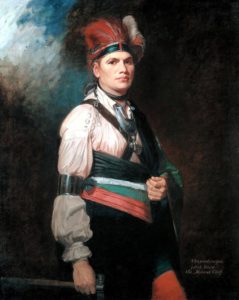
Joseph Thayendanegea Brant
There were no Haudenosaunee invited to take part in this treaty that not only ended the war and created a new country, but would also strip them of a land base on which to live.
In 1784 and refugees within their former territories, some 2,000 Haudenosaunee followed Joseph Brant west to the relative safety of Fort Niagara to wait for the tract of lands along the Grand River to be declared theirs.
Other Mohawks, particularly from the Fort Hunter area of the Mohawk Valley, would flee north across the St.Lawrence River, to begin their new lives in a tract of land known as Tyendinaga on the Bay of Quinte, so named for Joseph Brant who was the primary negotiator and spokesman pleading the case for his people to the British Crown.
The Dorchester Proclamation of 1789 stipulated that,
“N.B. Those Loyalists who have adhered to the unity of the Empire, and joined the
Royal Standard before the Treaty of Separation in the year 1783, and all their children
and their descendants by either sex, are to be distinguished by the following capitals,
affixed to their names: U.E. alluding to their great principle the unity of the Empire.”
Essentially, this defined who could be considered a United Empire Loyalist and by any assessment, this most certainly included the Haudenosaunee people who sacrificed and suffered losses as a result of aligning with the British and not the rebels.
 This heritage is as much a part of the history of how and why the Haudenosaunee arrived and began to live in what would become Canada as it is of those non-Native comrades who chose to be loyal as a matter of preference or simply conscience.
This heritage is as much a part of the history of how and why the Haudenosaunee arrived and began to live in what would become Canada as it is of those non-Native comrades who chose to be loyal as a matter of preference or simply conscience.
While the history of the Haudenosaunee in the immediate area of Akwesasne stems primarily from a separate migration from Kahnawake near Montréal beginning in 1755, after the Revolutionary War there were some Mohawk people who chose to settle in the existing community of Akwesasne rather than begin an entirely new community at Tyendinaga.
Thus, it’s entirely probable there are families on Akwesasne who are entitled to claim their United Empire Loyalist heritage if they so choose. Indeed, given the centuries of marriages betwen the various Haudenosaunee communities, it stands to reason there are Mohawks who are United Empire Loyalists on each of the communities.
It’s important to recognize and understand the relationship between the First Nations and the Canadian Monarchy; officially, it’s a well-known fact that the people of the First Nations are not ‘subjects’ of the Crown, rather, they are considered ‘Allies’ of the Crown.
It’s been said that if a Mohawk likes someone, that person has a friend – an ally – for life; they will stand by their friend through any adversity.
Given the history of Haudenosaunee warriors fighting in all wars and conflicts around the world, few can argue of the pride and honour that is given to the Haudenosaunee who could have just as easily ignored their friends in need, yet rose to the challenge and given the ultimate sacrifice.
It’s this sentiment that United Empire Loyalists are anxious to preserve.
It’s also easy enough to speculate what was the compelling rationale that went through the minds of people who’ve been dead for centuries, but in reality, this is as pointless as imagining descendants 200 years from now will be capable of accurately assessing what motivates each of us today.
The heritage of the United Empire Loyalists is a mark of honour that pays tribute to ancestors who chose to take a defiant stand for a principle.
For those who choose to claim and celebrate this, the UELAC is always eager to welcome and assist them.
![]()
The Ohsweken Genealogy Society is a non-profit organization that was formed in 2000. The focus of our research is the Six Nations of the Grand River in Tuscarora Township, Brant County, Ontario. We are dedicated to preserving and honouring our ancestors by finding out who we are and where we come from.
Click logo to connect with Ohsweken Genealogical Society
Traditional Ceremonies & Dances
Haudenosaunee Traditional Dance: Smoke Dance
2019 Akwesasne International Pow Wow (Akwesasne TV)
Further Reading:
The History of Akwesasne from Pre-Contact to Modern Times by Darren Bonaparte
The Landing of the Mohawks of the Bay of Quinte
Loyalism at Akwesasne and Glengarry in the Age of Revolution
Haudenosaunee (Iroquois) (The Canadian Encyclopedia)
Mary Konwatsi’tsiaienni and Joseph Thayendanegea Brant (Canadian War Museum)
Mary Brant, Konwatsi’tsiaienni (Wikipedia)
Molly Brant (Cataraqui Archeaological Research Foundation)
Joseph Thayendanegea Brant (Grand River UELAC)
The Six Nations Confederacy During the American Revolution – Fort Stanwix National Monument
War 1812-1814
Mohawk Warriors killed and wounded in June 1813 – Eastern Door, Eric Pouliot-Thisdale, January 15, 2016
